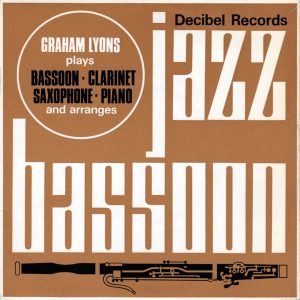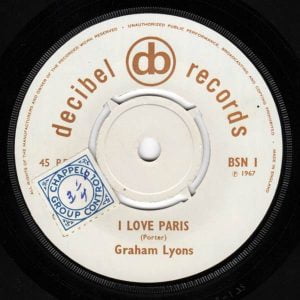My main area of research in the past few years has been the use of the bassoon in jazz; in fact, I wrote my dissertation on the subject. But I’ve thus far neglected writing about it here, mostly because there’s too much information to condense into a single blog post! I’ll get around to writing a historical overview at some point, but for now, suffice it to say that there have been hundreds of jazz recordings (close to a thousand, actually) that include bassoonists in various roles, dating back to at least the early 1920s.
Today, as a starting point, I’m going to write about a recent addition to my own record collection: a 45rpm single entitled Jazz Bassoon. The record was pressed in 1967, and features Graham Lyons on bassoon (also, as the cover points out, on clarinet, sax, piano, and as arranger). I often hunt for particular records; this wasn’t one of those. In fact, even though I’ve assembled an extensive discography of jazz recording sessions involving bassoon, I had exactly zero knowledge of this disc before it popped up on eBay.
I knew a bit about Graham Lyons himself, though. Among other things, he recorded a few tunes on bassoon, clarinet, and bari sax with the British trad jazz band The Temperance Seven in the early 60s. Lyons has led a varied career as a performer, composer, and teacher of multiple woodwind instruments. One of his recent endeavors is the Clarinéo, a simplified plastic clarinet for young players. But this recording of his, released on a tiny label (that may in fact have been owned by Lyons himself), had flown completely under my radar.
The A side of this disc is a Lyons original entitled “Bassoonova.” This tune has been either re-released or re-recorded on a CD titled Sonata — The Woodwind Music of Graham Lyons, so I won’t post it here. It is, as you’d expect, a bossa nova. Lyons takes a relatively lengthy solo on bassoon in addition to playing all the parts in sections of four-part bassoon harmony and dual clarinets. All of this is supported by a rhythm section of Lyons again on piano, Rob Rubin on bass, and Bill Eyden on drums.
The B side, Cole Porter’s “I Love Paris,” has a multi-part intro that starts off with two bassoons over a piano/bass drone. Once the band hits the tune itself, Lyons plays just a bit of the melody on bassoon before taking a chorus and a half worth of solo. He follows this with brief solos on bari sax, clarinet, and piano. But here, listen for yourself:
The back side of the sleeve has actual notes — rare on 7″ singles, at least in my experience. These confirm what we might guess from the title, that Lyons is with this record trying to make the point that the bassoon can be a viable jazz instrument. “I wanted to show the bassoon in all its registers,” Lyons writes, “the different ways it could be used, and how it would fit in a jazz setting.” He also touches on what he sees as the main reason the bassoon hasn’t been used more in jazz: “A tricky phrase which might take fifteen minutes to practice and get right on a clarinet or saxophone is sure to take an hour on the bassoon.” This is a great addition to my quotes file, and echoes published comments by other jazz bassoon players like Illinois Jacquet and Paul Hanson (more on them another time).



5 Responses
Dave,
Thanks for telling about the recording.
He has a nice sound and pretty fluid in his
improv. I like that his keeping the acoustic
sound of the horn. A bit reminiscent of Errol
Buddle in the Australian Jazz Quintet.
Sure thing! Yes, the whole arrangement sounds very AJQ-ish. The sleeve notes mention Buddle, so I’m betting that his playing was a direct influence here.
Yes, my label.
25 years ago, I threw away all but a few of them.
I hadn’t heard Errol Buddle by then. I wasn’t influenced by any one musician. I listened to so much improvised jazz at the time—Clifford Brown, Getz, Stitt, Mobley, Tubby Hayes, Peterson, de Franco, Cannonball.
Aha, thanks Mr. Lyons! I’m very interested in knowing about influences on people who’ve played jazz bassoon — particularly whether they’ve listened to other jazz bassoonists or not. So, every bit of information one way or the other is helpful.
And if you disposed of most of these records, I feel very lucky indeed to have come across one. I thoroughly enjoy it!
[…] Jazz Bassoon — Graham Lyons […]